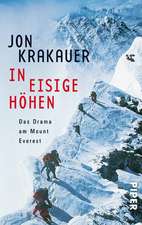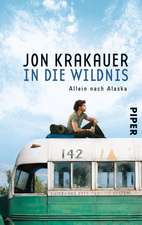Into Thin Air: Anchor Books
Autor Jon Krakaueren Limba Engleză Paperback – 18 oct 1999
Vezi toate premiile Carte premiată
Book Sense Book of the Year Award (1998), National Book Critics Circle Award (1997), Pacific Northwest Booksellers Association Award (1998)
A bank of clouds was assembling on the not-so-distant horizon, but journalist-mountaineer Jon Krakauer, standing on the summit of Mt. Everest, saw nothing that "suggested that a murderous storm was bearing down." He was wrong. The storm, which claimed five lives and left countless more--including Krakauer's--in guilt-ridden disarray, would also provide the impetus for Into Thin Air, Krakauer's epic account of the May 1996 disaster.
By writing Into Thin Air, Krakauer may have hoped to exorcise some of his own demons and lay to rest some of the painful questions that still surround the event. He takes great pains to provide a balanced picture of the people and events he witnessed and gives due credit to the tireless and dedicated Sherpas. He also avoids blasting easy targets such as Sandy Pittman, the wealthy socialite who brought an espresso maker along on the expedition. Krakauer's highly personal inquiry into the catastrophe provides a great deal of insight into what went wrong. But for Krakauer himself, further interviews and investigations only lead him to the conclusion that his perceived failures were directly responsible for a fellow climber's death. Clearly, Krakauer remains haunted by the disaster, and although he relates a number of incidents in which he acted selflessly and even heroically, he seems unable to view those instances objectively. In the end, despite his evenhanded and even generous assessment of others' actions, he reserves a full measure of vitriol for himself.
This updated trade paperback edition of Into Thin Air includes an extensive new postscript that sheds fascinating light on the acrimonious debate that flared between Krakauer and Everest guide Anatoli Boukreev in the wake of the tragedy. "I have no doubt that Boukreev's intentions were good on summit day," writes Krakauer in the postscript, dated August 1999. "What disturbs me, though, was Boukreev's refusal to acknowledge the possibility that he made even a single poor decision. Never did he indicate that perhaps it wasn't the best choice to climb without gas or go down ahead of his clients." As usual, Krakauer supports his points with dogged research and a good dose of humility. But rather than continue the heated discourse that has raged since Into Thin Air's denouncement of guide Boukreev, Krakauer's tone is conciliatory; he points most of his criticism at G. Weston De Walt, who coauthored The Climb, Boukreev's version of events. And in a touching conclusion, Krakauer recounts his last conversation with the late Boukreev, in which the two weathered climbers agreed to disagree about certain points. Krakauer had great hopes to patch things up with Boukreev, but the Russian later died in an avalanche on another Himalayan peak, Annapurna I.
In 1999, Krakauer received an Academy Award in Literature from the American Academy of Arts and Letters--a prestigious prize intended "to honor writers of exceptional accomplishment." According to the Academy's citation, "Krakauer combines the tenacity and courage of the finest tradition of investigative journalism with the stylish subtlety and profound insight of the born writer. His account of an ascent of Mount Everest has led to a general reevaluation of climbing and of the commercialization of what was once a romantic, solitary sport; while his account of the life and death of Christopher McCandless, who died of starvation after challenging the Alaskan wilderness, delves even more deeply and disturbingly into the fascination of nature and the devastating effects of its lure on a young and curious mind."
| Toate formatele și edițiile | Preț | Express |
|---|---|---|
| Paperback (2) | 47.83 lei 3-5 săpt. | +31.98 lei 4-10 zile |
| Pan Macmillan – 11 ian 2024 | 47.83 lei 3-5 săpt. | +31.98 lei 4-10 zile |
| Anchor Books – 18 oct 1999 | 96.71 lei 3-5 săpt. | +26.94 lei 4-10 zile |
| Hardback (1) | 181.46 lei 3-5 săpt. | |
| Villard Books – 31 mar 1997 | 181.46 lei 3-5 săpt. |
Din seria Anchor Books
-
 Preț: 91.12 lei
Preț: 91.12 lei -
 Preț: 83.71 lei
Preț: 83.71 lei -
 Preț: 72.23 lei
Preț: 72.23 lei -
 Preț: 108.42 lei
Preț: 108.42 lei -
 Preț: 81.56 lei
Preț: 81.56 lei -
 Preț: 89.50 lei
Preț: 89.50 lei -
 Preț: 81.71 lei
Preț: 81.71 lei -
 Preț: 89.37 lei
Preț: 89.37 lei -
 Preț: 59.05 lei
Preț: 59.05 lei -
 Preț: 117.24 lei
Preț: 117.24 lei -
 Preț: 66.59 lei
Preț: 66.59 lei -
 Preț: 128.89 lei
Preț: 128.89 lei - 13%
 Preț: 98.23 lei
Preț: 98.23 lei -
 Preț: 59.83 lei
Preț: 59.83 lei -
 Preț: 71.23 lei
Preț: 71.23 lei -
 Preț: 134.65 lei
Preț: 134.65 lei -
 Preț: 98.73 lei
Preț: 98.73 lei -
 Preț: 311.72 lei
Preț: 311.72 lei -
 Preț: 141.06 lei
Preț: 141.06 lei -
 Preț: 91.63 lei
Preț: 91.63 lei -
 Preț: 50.16 lei
Preț: 50.16 lei -
 Preț: 89.48 lei
Preț: 89.48 lei -
 Preț: 77.77 lei
Preț: 77.77 lei -
 Preț: 106.67 lei
Preț: 106.67 lei -
 Preț: 111.51 lei
Preț: 111.51 lei - 16%
 Preț: 79.33 lei
Preț: 79.33 lei -
 Preț: 70.46 lei
Preț: 70.46 lei -
 Preț: 88.89 lei
Preț: 88.89 lei -
 Preț: 54.62 lei
Preț: 54.62 lei -
 Preț: 64.09 lei
Preț: 64.09 lei -
 Preț: 89.04 lei
Preț: 89.04 lei -
 Preț: 106.14 lei
Preț: 106.14 lei -
 Preț: 123.46 lei
Preț: 123.46 lei -
 Preț: 91.38 lei
Preț: 91.38 lei - NaN%
 Preț: 78.31 lei
Preț: 78.31 lei -
 Preț: 144.11 lei
Preț: 144.11 lei -
 Preț: 115.65 lei
Preț: 115.65 lei -
 Preț: 91.64 lei
Preț: 91.64 lei -
 Preț: 94.88 lei
Preț: 94.88 lei -
 Preț: 78.36 lei
Preț: 78.36 lei -
 Preț: 91.13 lei
Preț: 91.13 lei -
 Preț: 135.88 lei
Preț: 135.88 lei -
 Preț: 100.73 lei
Preț: 100.73 lei -
 Preț: 80.43 lei
Preț: 80.43 lei -
 Preț: 91.55 lei
Preț: 91.55 lei -
 Preț: 92.99 lei
Preț: 92.99 lei -
 Preț: 81.66 lei
Preț: 81.66 lei -
 Preț: 89.06 lei
Preț: 89.06 lei
Preț: 96.71 lei
Nou
Puncte Express: 145
Preț estimativ în valută:
18.51€ • 19.25$ • 15.28£
18.51€ • 19.25$ • 15.28£
Carte disponibilă
Livrare economică 24 martie-07 aprilie
Livrare express 07-13 martie pentru 36.93 lei
Preluare comenzi: 021 569.72.76
Specificații
ISBN-13: 9780385494786
ISBN-10: 0385494785
Pagini: 368
Ilustrații: illustrations, maps
Dimensiuni: 134 x 206 x 21 mm
Greutate: 0.28 kg
Ediția:Anchor Bks Trad.
Editura: Anchor Books
Colecția Anchor Books
Seria Anchor Books
ISBN-10: 0385494785
Pagini: 368
Ilustrații: illustrations, maps
Dimensiuni: 134 x 206 x 21 mm
Greutate: 0.28 kg
Ediția:Anchor Bks Trad.
Editura: Anchor Books
Colecția Anchor Books
Seria Anchor Books
Recenzii
"... he has produced a narrative that is both meticulously researched and deftly constructed. Unlike the expedition, his story rushes irresistibly forward. But perhaps Mr. Krakauer's greatest achievement is his evocation of the deadly storm, his ability to re-create its effects with a lucid and terrifying intimacy." —Alastair Scott, The New York Times Book Review
"This is a great book, among the best ever on mountaineering. Gracefully and efficiently written, carefully researched, and actually lived by its narrator, it shares a similar theme with another sort of book, a novel called "The Great Gatsby." —The Washington Post
"Into Thin Air ranks among the great adventure books of all time." —The Wall Street Journal
"Krakauer is an extremely gifted storyteller as well as a relentlessly honest and even-handed journalist, the story is riveting and wonderfully complex in its own right, and Krakauer makes one excellent decision after another about how to tell it.... To call the book an adventure saga seems not to recognize that it is also a deeply thoughtful and finely wrought philosophical examination of the self." —Elle
"Hypnotic, rattling.... Time collapses as, minute by minute, Krakauer rivetingly and movingly chronicles what ensued, much of which is near agony to read.... A brilliantly told story that won't go begging when the year's literary honors are doled out." —Kirkus Reviews
"Though it comes from the genre named for what it isn't (nonfiction), this has the feel of literature: Krakauer is Ishmael, the narrator who lives to tell the story but is forever trapped within it.... Krakauer's reporting is steady but ferocious. The clink of ice in a glass, a poem of winter snow, will never sound the same." —Mirabella
"Into Thin Air is a remarkable work of reportage and self-examination.... And no book on the 1996 disaster is likely to consider so honestly the mistakes that killed his colleagues." —Newsday
"A harrowing tale of the perils of high-altitude climbing, a story of bad luck and worse judgment and of heartbreaking heroism." —People
"In this movingly written book, Krakauer describes an experience of such bone-chilling horror as to persuade even the most fanatical alpinists to seek sanctuary at sea level." —Sports Illustrated
"This is a great book, among the best ever on mountaineering. Gracefully and efficiently written, carefully researched, and actually lived by its narrator, it shares a similar theme with another sort of book, a novel called "The Great Gatsby." —The Washington Post
"Into Thin Air ranks among the great adventure books of all time." —The Wall Street Journal
"Krakauer is an extremely gifted storyteller as well as a relentlessly honest and even-handed journalist, the story is riveting and wonderfully complex in its own right, and Krakauer makes one excellent decision after another about how to tell it.... To call the book an adventure saga seems not to recognize that it is also a deeply thoughtful and finely wrought philosophical examination of the self." —Elle
"Hypnotic, rattling.... Time collapses as, minute by minute, Krakauer rivetingly and movingly chronicles what ensued, much of which is near agony to read.... A brilliantly told story that won't go begging when the year's literary honors are doled out." —Kirkus Reviews
"Though it comes from the genre named for what it isn't (nonfiction), this has the feel of literature: Krakauer is Ishmael, the narrator who lives to tell the story but is forever trapped within it.... Krakauer's reporting is steady but ferocious. The clink of ice in a glass, a poem of winter snow, will never sound the same." —Mirabella
"Into Thin Air is a remarkable work of reportage and self-examination.... And no book on the 1996 disaster is likely to consider so honestly the mistakes that killed his colleagues." —Newsday
"A harrowing tale of the perils of high-altitude climbing, a story of bad luck and worse judgment and of heartbreaking heroism." —People
"In this movingly written book, Krakauer describes an experience of such bone-chilling horror as to persuade even the most fanatical alpinists to seek sanctuary at sea level." —Sports Illustrated
Notă biografică
Jon Krakauer is a part-time mountaineer and a full-time writer. He is a contributing editor at Outside magazine and writes for many national magazines and newspapers. He lives in Seattle, Washington.
From the Paperback edition.
From the Paperback edition.
Extras
In March 1996, Outside Magazine sent me to Nepal to participate in, and write about, a guided ascent of Mount Everest. I went as one of eight clients on an expedition led by a well-known guide from New Zealand named Rob Hall. On May 10 I arrived on top of the mountain, but the summit came at a terrible cost.
Among my five teammates who reached the top, four, including Hall, perished in a rogue storm that blew in without warning while we were still high on the peak. By the time I'd descended to Base Camp nine climbers from four expeditions were dead, and three more lives would be lost before the month was out.
The expedition left me badly shaken, and the article was difficult to write. Nevertheless, five weeks after I returned from Nepal I delivered a manuscript to Outside, and it was published in the September issue of the magazine. Upon its completion I attempted to put Everest out of my mind and get on with my life, but that turned out to be impossible. Through a fog of messy emotions, I continued trying to make sense of what had happened up there, and I obsessively mulled the circumstances of my companions' deaths.
The Outside piece was as accurate as I could make it under the circumstances, but my deadline had been unforgiving, the sequence of events had been frustratingly complex, and the memories of the survivors had been badly distorted by exhaustion, oxygen depletion, and shock. At one point during my research I asked three other people to recount an incident all four of us had witnessed high on the mountain, and one of us could agree on such crucial facts as the time, what had been said, or even who had been present. Within days after the Outside article went to press, I discovered that a few of the details I'd reported were in error. Most were minor inaccuracies of the sort that inevitably creep into works of deadline journalism, but one of my blunders was in no sense minor, and it had a devastating impact on the friends and family of one of the victims.
Only slightly less disconcerting than the article's factual errors was the material that necessarily had to be omitted for lack of space. Mark Bryant, the editor of Outside, and Larry Burke, the publisher, had given me an extraordinary amount of room to tell the story: they ran the piece at 17,000 words -- four or five times as long as a typical magazine feature. Even so, I felt that it was much too abbreviated to do justice to the tragedy. The Everest climb had rocked my life to its core, and it became desperately important for me to record the events in complete detail, unconstrained by a limited number of column inches. This book is the fruit of that compulsion.
The staggering unreliability of the human mind at high altitude made the research problematic. To avoid relying excessively on my own perceptions, I interviewed most of the protagonists at great length and on multiple occasions. When possible I also corroborated details with radio logs maintained by people at Base Camp, where clear thought wasn't in such short supply. Readers familiar with the Outside article may notice discrepancies between certain details (primarily matters of time) reported in the magazine and those reported in the book; the revisions reflect new information that has come to light since publication of the magazine piece.
Several authors and editors I respect counseled me not to write the book as quickly as I did; they urged me to wait two or three years and put some distance between me and the expedition in order to gain some crucial perspective. Their advice was sound, but in the end I ignored it -- mostly because what happened on the mountain was gnawing my guts out. I thought that writing the book might purge Everest from my life.
It hasn't, of course. Moreover, I agree that readers are often poorly served when an author writes as an act of catharsis, as I have done here. But I hoped something would be gained by spilling my soul in the calamity's immediate aftermath, in the roil and torment of the moment. I wanted my account to have a raw, ruthless sort of honesty that seemed in danger of leaching away with the passage of time and the dissipation of anguish.
Some of the same people who warned me against writing hastily had also cautioned me against going to Everest in the first place. There were many, many fine reasons not to go, but attempting to climb Everest is an intrinsically irrational act -- a triumph of desire over sensibility. Any person who would seriously consider it is almost by definition beyond the sway of reasoned argument.
The plain truth is that I knew better but went to Everest anyway. And in doing so I was a party to the death of good people, which is something that is apt to remain on my conscience for a very long time.
Among my five teammates who reached the top, four, including Hall, perished in a rogue storm that blew in without warning while we were still high on the peak. By the time I'd descended to Base Camp nine climbers from four expeditions were dead, and three more lives would be lost before the month was out.
The expedition left me badly shaken, and the article was difficult to write. Nevertheless, five weeks after I returned from Nepal I delivered a manuscript to Outside, and it was published in the September issue of the magazine. Upon its completion I attempted to put Everest out of my mind and get on with my life, but that turned out to be impossible. Through a fog of messy emotions, I continued trying to make sense of what had happened up there, and I obsessively mulled the circumstances of my companions' deaths.
The Outside piece was as accurate as I could make it under the circumstances, but my deadline had been unforgiving, the sequence of events had been frustratingly complex, and the memories of the survivors had been badly distorted by exhaustion, oxygen depletion, and shock. At one point during my research I asked three other people to recount an incident all four of us had witnessed high on the mountain, and one of us could agree on such crucial facts as the time, what had been said, or even who had been present. Within days after the Outside article went to press, I discovered that a few of the details I'd reported were in error. Most were minor inaccuracies of the sort that inevitably creep into works of deadline journalism, but one of my blunders was in no sense minor, and it had a devastating impact on the friends and family of one of the victims.
Only slightly less disconcerting than the article's factual errors was the material that necessarily had to be omitted for lack of space. Mark Bryant, the editor of Outside, and Larry Burke, the publisher, had given me an extraordinary amount of room to tell the story: they ran the piece at 17,000 words -- four or five times as long as a typical magazine feature. Even so, I felt that it was much too abbreviated to do justice to the tragedy. The Everest climb had rocked my life to its core, and it became desperately important for me to record the events in complete detail, unconstrained by a limited number of column inches. This book is the fruit of that compulsion.
The staggering unreliability of the human mind at high altitude made the research problematic. To avoid relying excessively on my own perceptions, I interviewed most of the protagonists at great length and on multiple occasions. When possible I also corroborated details with radio logs maintained by people at Base Camp, where clear thought wasn't in such short supply. Readers familiar with the Outside article may notice discrepancies between certain details (primarily matters of time) reported in the magazine and those reported in the book; the revisions reflect new information that has come to light since publication of the magazine piece.
Several authors and editors I respect counseled me not to write the book as quickly as I did; they urged me to wait two or three years and put some distance between me and the expedition in order to gain some crucial perspective. Their advice was sound, but in the end I ignored it -- mostly because what happened on the mountain was gnawing my guts out. I thought that writing the book might purge Everest from my life.
It hasn't, of course. Moreover, I agree that readers are often poorly served when an author writes as an act of catharsis, as I have done here. But I hoped something would be gained by spilling my soul in the calamity's immediate aftermath, in the roil and torment of the moment. I wanted my account to have a raw, ruthless sort of honesty that seemed in danger of leaching away with the passage of time and the dissipation of anguish.
Some of the same people who warned me against writing hastily had also cautioned me against going to Everest in the first place. There were many, many fine reasons not to go, but attempting to climb Everest is an intrinsically irrational act -- a triumph of desire over sensibility. Any person who would seriously consider it is almost by definition beyond the sway of reasoned argument.
The plain truth is that I knew better but went to Everest anyway. And in doing so I was a party to the death of good people, which is something that is apt to remain on my conscience for a very long time.
Descriere
Now available in paperback comes the bestselling adventure book by Jon Krakauer, the acclaimed author of "Into the Wild". When disaster struck during his ascent of Mt. Everest, killing eight climbers, Krakauer survived by luck, skill, and discipline. Now, he has written the definitive account of this headline-making tragedy. Illustrations.
Textul de pe ultima copertă
When Jon Krakauer reached the summit of Mt. Everest in the early afternoon of May 10, 1996, he hadn't slept in fifty-seven hours and was reeling from the brain-altering effects of oxygen depletion. As he turned to begin his long, dangerous descent from 29,028 feet, twenty other climbers were still pushing doggedly toward the top. No one had noticed that the sky had begun to fill with clouds. Six hours later and 3,000 feet lower, in 70-knot winds and blinding snow, Krakauer collapsed in his tent, freezing, hallucinating from exhaustion and hypoxia, but safe. The following morning he learned that six of his fellow climbers hadn't made it back to their camp and were in a desperate struggle for their lives. When the storm finally passed, five of them would be dead, and the sixth so horribly frostbitten that his right hand would have to be amputated. Krakauer examines what it is about Everest that has compelled so many people - including himself - to throw caution to the wind, ignore the concerns of loved ones, and willingly subject themselves to such risk, hardship, and expense. Written with emotional clarity and supported by his unimpeachable reporting, Krakauer's eye-witness account of what happened on the roof of the world is a singular achievement.
Premii
- Book Sense Book of the Year Award Nominee, 1998
- National Book Critics Circle Award Nominee, 1997
- Pacific Northwest Booksellers Association Award Winner, 1998
- ALA Notable Books Winner, 1998
- Black-Eyed Susan Award Nominee, 1999
- Alex Awards Winner, 1998















